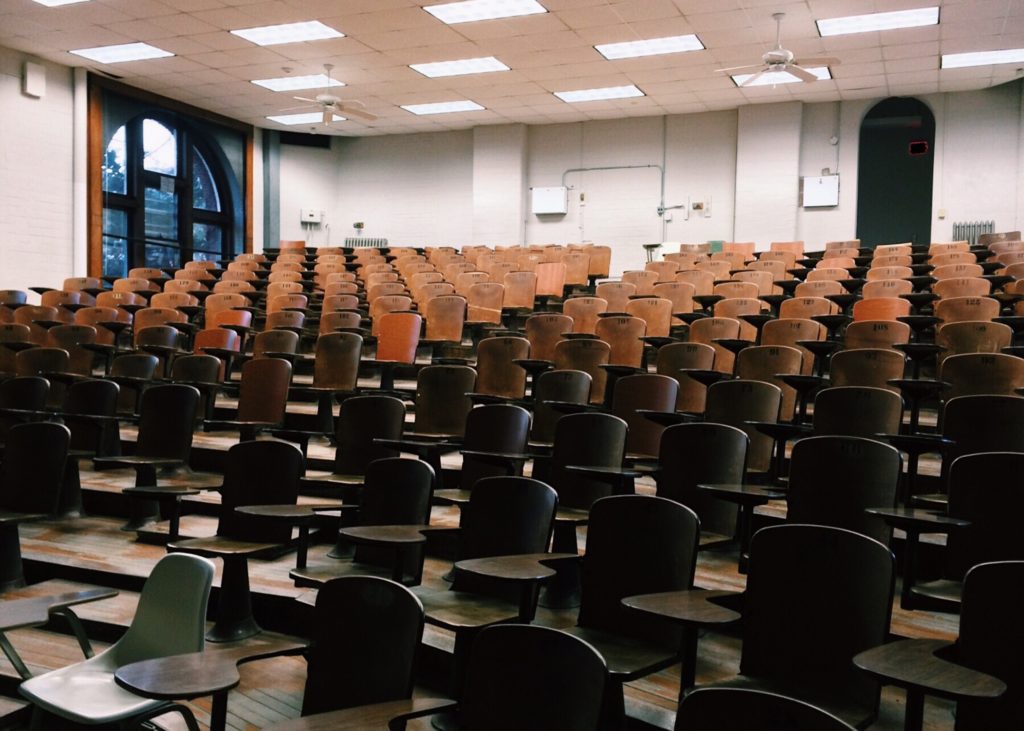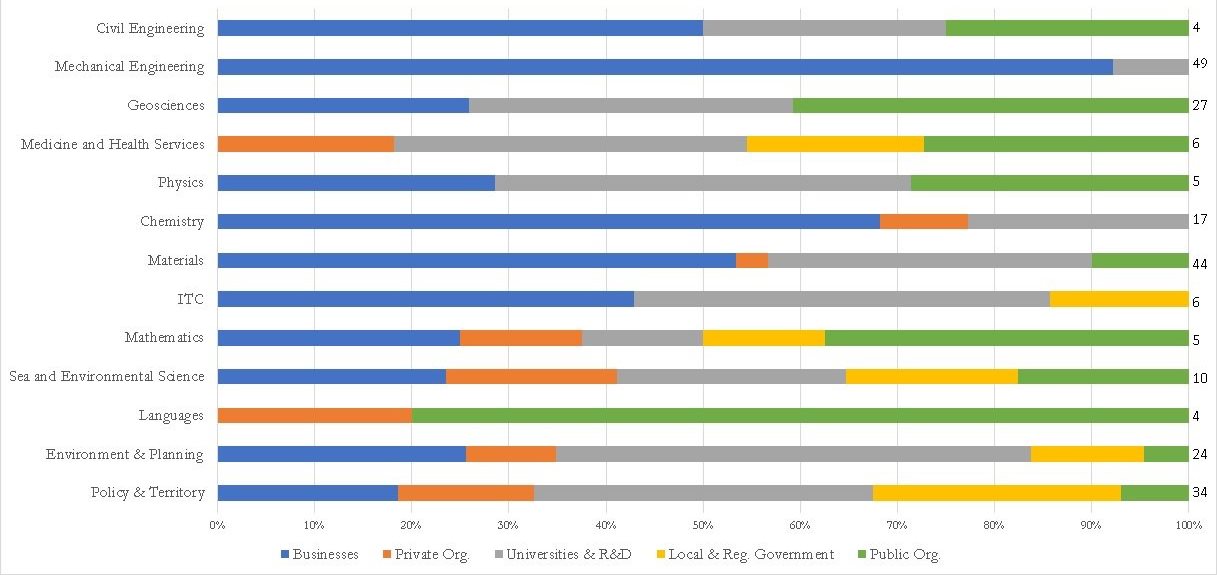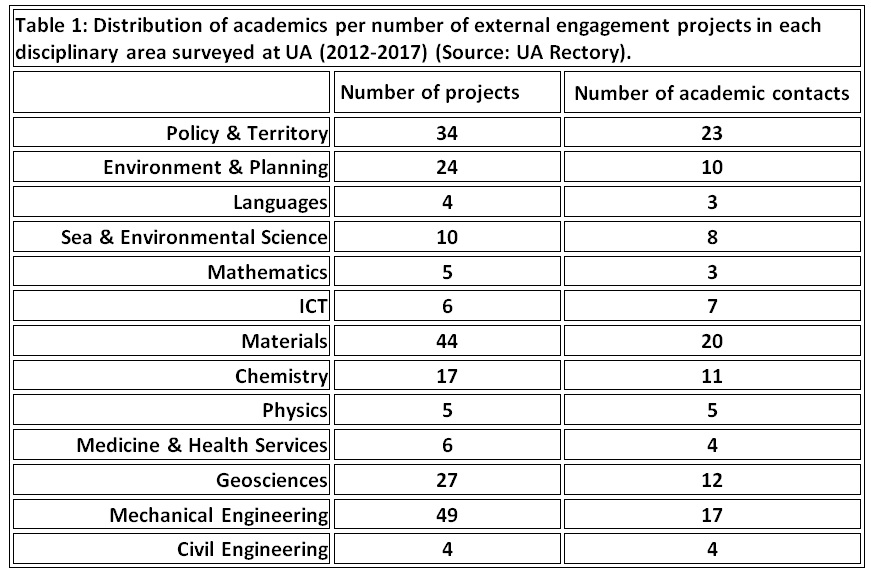To Engage or Not to Engage? Developing Academic Drivers for Collaborating with Local and Regional Government in Policy-Design

DOI reference: 10.1080/13673882.2018.00001011
By Liliana Fonseca, PhD fellow in Public Policy at University of Aveiro, Portugal.
Liliana Fonseca argues that universities are increasingly called upon to engage with local and regional government, but do they possess the needed mechanisms to incentivise academics to do so? In this article Liliana explores the barriers that prohibit the effective linking of these institutions and suggest potential policies that can be implemented to broaden the interpretation of the third mission within universities.
:Highlights:
- A broader interpretation of the third mission is needed to effectively nurture engagement with public institutions;
- Present organisational mechanisms within universities must be adjusted and developed to consider non-financial drivers of engagement;
- Preliminary data from the ongoing PhD programme, to be expanded upon in a forthcoming paper on the case of the University of Aveiro.
Introduction
An institutionalised mission of engagement
In recent decades there has been increased recognition of the changing role of universities. Universities have developed, to a greater or lesser degree, in close dialectic with society, aiding its progress, whilst in turn, being moulded by society. With growing pressure for them to contribute toward the development of the region’s in which they are located and become more embedded in territorial knowledge networks (Uyarra, 2010), their internal structure has had to adapt to the wider implications of these new roles and the functional impact they can have in society.
Policy-makers and firms increasingly recognise their value in contributing to and stimulating innovation and learning dynamics, leading to growing pressure on universities to accept broader responsibilities toward society. This originates not just from an inherent civic duty possessed by Higher Education Institutions (HEIs), but also a logical accountability to their public and private sponsors (Zomer & Benneworth, 2011). HEIs have incorporated this responsibility into their institutional nature, formalising the third academic mission of regional engagement, the first and second being teaching and research. In its application, the third mission refers to the linkages universities form with external organisations – e.g. government bodies, industry, social enterprises, the public, with an underlying aim of contributing towards the development of society. These linkages materialise in different forms, namely consulting, collaborative research, joint projects and other more informal relations and activities enabled through networking.
To support and stimulate these linkages, universities’ internal management and operations have changed. Third mission conceptualisations encouraged the emergence of various models to help frame activities in this area. These include the entrepreneurial university model, emphasising the university as ‘knowledge factory’ and promoting the development of linkages with external actors (mainly businesses) for diversified funding; the triple helix model of university-industry-government relationships, with these nodes interfacing supported by organisational arrangements, incentive structures and intermediates (e.g. technology transfer offices); and the civic university model, which emphasises holistic, purposeful and institution-wide engagement with all areas of society for its betterment. These theories demonstrate a trend in the literature on university engagement, to move from a commercialisation-based relational role to a broader ‘developmental’ approach to engagement with society (Uyarra, 2010).
University-industry links have, nonetheless, been commonly prioritised. With an economic perspective focused on innovation and development prevailing throughout the years, as both academic and political discourse have emphasised the marketability of science and technology-based knowledge. This is reinforced in the term ‘technology transfer’ (not simply knowledge transfer) when referring to academic exchanges with the outside world. It also follows the belief that technical disciplines are inherently more oriented towards applying and transferring knowledge than the humanities and social science (Krücken, 2003).
This is also evident when referring to the type of partners a university can engage with. Preliminary data from a survey of several departments at the University of Aveiro (UA), from disciplines in exact and social sciences, demonstrates that there is a higher number of exchanges taking place with the private sector.
Figure 1: Types and Proportions of Partners in External Engagement Projects per Discipline at UA. Source: UA rectory. Graph is own elaboration.

The vast majority of engagement activities carried out by departments and research institutes in the designated disciplines were with private sector organisations, with businesses forming the largest single group. Those disciplines considered more technical have a greater proportion of projects with the private sector than with any other organisations, with only a few exceptions in the Geosciences, Medicine and Health Services, Physics and Environment & Planning. The number of activities disclosed by the departments and research units surveyed also implies active engagement cultures in disciplines such as Mechanical Engineering, Geosciences, Materials, Environment & Planning and Public Policy. The highest proportion of partners is clearly businesses in the exact sciences (except Geosciences), followed by other academic institutions and the public sector. In social science-based disciplines, universities and research institutions and the public sector are more predominant. This is similar not just in social-science disciplines, but also in technical fields, such as Sea & Environmental science and Mathematics. These include collaborations with public citizens’ associations, but also local and regional government (LRG). These linkages are, therefore, not the sole province of social sciences and humanities, indicating a need to understand how they take place and, most of all, if the incentives in place (or lack thereof) affect levels of engagement.
Knowledge exchange and engagement mechanisms are not therefore limited to commercialisation and profit-led notions, and involve academics from all disciplines, not just technological ones. Similarly, external partners are not strictly businesses or industries from the private sector. Accompanying a broadening vision of innovation, they may include government agencies at various scales, as well as other public or third sector organisations. As such, there is a need to reconsider university engagement in broader terms, and equally to widen the interpretation of their impact in their region and what this means for innovation and development. With a growing focus in recent years on the role played by universities in driving development processes, asserted in the latest EU programmes for Cohesion Policy (e.g. smart specialisation), it is unsurprising that LRG is increasingly seeking the participation of universities to foster the development of regional innovation systems. This is not just in a technological sense, but encompasses more social dimensions. For this reason, academic engagement and its operationalisation must be rethought and adapted, if it is to deliver the goals of this policy agenda.
Does institutionalisation imply practice?
The institutionalization of the third academic mission was a formal recognition of the importance of university engagement for LRG processes, but this acknowledgement does not directly imply its successful implementation and management. Albeit frequently associated with critical thinking and innovation dynamics, HEIs are still one of the oldest and most stable institutions in society and are thus prone to stagnation and a prioritisation of traditional roles. The third mission often comes in third place, with teaching and research as more comfortable and incentivised activities for academics. Within the third mission there are two major scales at play: the institutional scale, that sets in place the priorities and the overarching model of engagement for the academic community; and the individual scale, where most interaction takes place and whose action is directly a result of its environment, attributes and drivers.
The institutional scale: are there mechanisms in place to support engagement?
The third mission runs into certain institutional barriers to its adoption. Each university possesses an orientation towards engagement and towards its regional priorities and responsibilities. This is shaped not just by its surroundings, but also its history, organisational structure and leaders. In interviews conducted within 6 departments of the University of Aveiro (UA), these factors were found to be determinant. The UA was highly influenced by the context of its creation, in which regional stakeholders pushed for an HEI to be created to reinvigorate region’s industrial sector. It was a university that from the beginning sought and was expected to, be entrepreneurial. Given this orientation, and the dependence on each leader’s vision of engagement, the organisational structure of UA was developed with channels and mechanisms to support this: the technology transfer office (UATEC), the University-Business office, technological platforms and other positions for staff to manage specific aspects of these relationships. In recent years, UA has even adapted staff evaluation processes to assess engagement.
Nevertheless, interviewees suggested a mismatch between UA’s mission statements and the mechanisms it has employed. Its regional engagement discourse did not effectively translate into practice, with a notable absence of a clear strategy for the third mission. While teaching and research have defined goals and expected outcomes, for example an increase in 10% on article output, no equal programme of objectives for engagement exists. As is, this does not sufficiently convey the importance of the third mission to the academic community, potentially leading to more passive, and reactive attitudes from staff regarding external collaboration.
The restrictive emphasis on entrepreneurialism and technology transfer, were largely seen by interviewees to be the result of a discourse that emphasises the search for alternative funding sources and a political environment promoting more corporate forms of university management. It was seen to limit the choice of engagement projects, emphasise the importance of high-value partnerships versus others that were less profit-led (but perhaps equally as relevant for the region), and to prioritise technical disciplines over more social ones. This poses the question of whether knowledge transfer is in fact more prevalent in the exact and technological sciences, or whether the biased association of industry links to profit has shaped engagement mechanisms at the institutional level, excluding from the outset other disciplines from such activities, and causing academics in these fields to internalise the notion that they have less to contribute to the third mission of universities.
The individual scale: are academics motivated to engage?
The effective operationalisation of the third mission inevitably depends on individual academics accepting and adopting changes to their norms and routines. Focusing on the academic researchers’ positioning in matters of regional engagement can thus improve the understanding of the motivations for collaboration and contribute towards the design of institutional-level policies that facilitate this linkage.
Universities, as ‘loosely coupled’ organisations, favour autonomous action in their professionals to achieve institutional goals. This means that, despite the influence of the universities’ overarching orientation, individual academics tend to pursue engagement activities on a discretionary basis, driven by personal preferences or motivations, and leading to both formal and informal collaboration channels.
Certain aspects have been determined to influence academics’ drive to engage: their level of experience and ‘rank’ within their department, with younger, less-experienced academics more easily embracing engagement; department culture, routines and policies around engagement, with individuals more likely to engage if others around them do so; and the availability of resources or the overall quality of research in their unit (Bercovitz & Feldman, 2007). Those individuals that have successfully engaged before and created a network of contacts are also prone to do so again and attract the attention of other external partners.
Individual skills and engagement capacity and interest inevitably influence whether an academic engages or not. However, academics, like most people, have an inherent ethical desire to help others and to benefit society with their work. More than being guided by profit, academics are driven by intrinsic motivations (Grant, 2008), with engagement initiatives serving to deliver largely symbolic returns. Commercialisation is therefore not the most common motivating factor for engagement.
Nevertheless, certain constraining factors limit the disposition of individuals to engage. According to interviews at UA, three major resources were identified as necessary for academic engagement: financial resources, human resources and time resources. The first highlights the (limited) budget available and the associated need for alternative sources of funding to justify external engagement. Limited funding availability influences the choice of projects and the capabilities that can be redirected to work on them. It also affects individual researchers’ capacity and willingness to engage, as the funding captured through a project does not necessarily reach them but is filtered through several organisational layers.
The second, human resources, directly relates to financial resources in two ways: without available budget, it is impossible to hire the staff needed for engagement projects; the hiring that does occur is on a precarious and temporary basis, with departments left incapable of maintaining them. This results in insufficient internal capacity to manage emerging relationships. Finally, the issue of time is a perennial one in the academic world, playing an important part in engagement. Most academics accumulate various jobs, mostly of an obligatory nature. Their schedule tends to be filled with teaching and research responsibilities that in academia determine career progression and rankings. Therefore, contracted academics rarely have the work and schedule flexibility to commit themselves fully to an engagement project or to pursue emerging opportunities.
In this context, the mentioned resources are crucial components in deciding whether to engage or not. As one interviewee summarised: “Of course, our answer depends also in our capacity and in our department, we are not so many… (…) So we can only do what we have time to do.”.
Other barriers consistently figured in interviewees’ accounts were bureaucratic in nature, with an at-times obstructive organisational structure, multiple and uncertain channels, and difficult financial and administrative arrangements preventing engagement with external partners from the outset. Cultural differences or ‘language’ barriers also arose between academics and external partners with different expectations and time-frames that hampered a project’s development. Finally, restrictive methods of performance evaluation even led some researchers to downplay their active participation in engagement activities, as including it in their evaluation reports would lower their overall score.
Considering these constraints, it is unsurprising regional engagement has not been widely adopted by the academic community, but has been carried by a few entrepreneurial individuals, often in top management positions, with the necessary skills and drive to make and sustain these links. The preliminary survey data presented Table 1 also illustrates the highly skewed distribution of interaction in engagement projects: while in some disciplines the number of projects is nearly equal to that of academics involved, implying variability in the contacts within the university, in others, such as Policy and Territory, Environment and Planning, Materials and Geosciences, the difference is accentuated. The most jarring is Mechanical Engineering, with 17 academics to 49 projects.

This could be an indication of the influence of individual attributes in engagement, but also, as some interviewees suggested, of a conformity amongst academics to routines and known areas of activity. Besides a predisposition to engagement, academics nevertheless require the skills to do so. As highlighted in interviews, there is a certain profile to academics who engage with the outside world, a skillset, adaptability and facility to interact with others from different fields and organisations. Something that must be learned and stimulated, or it might hamper engagement more than nurture it.
Collaborating with local & regional government
Considering the struggles in the third mission’s institutionalisation in what are already much studied and almost ‘intuitive’ university-industry links, an important question arises about how this level of engagement might be fostered in the less clear cut fields of social science, especially in the face of growing expectations from LRG for policy-making.
First, the highly fragmented nature of LRG limits the capacity, resources and overall power these institutions (municipalities) can have in higher education and in economic development more generally. Resource combination of these fragmented units is a potential solution to increase the capacity to cooperate with universities. Naturally, having them work together implies overcoming potential tensions associated with administrative divisions. Intra-regional competition is a challenge universities often face and is especially complex when considering HEIs already strain to answer the few existing requests and opportunities for engagement they already have. A delicate balance is required here, in addressing diverse and scattered regional demands without privileging one given municipality at the cost of another, whilst at the same time avoiding the over-extension and dilution of resources and partnerships.
Second, incorporating universities’ science and technological knowledge in LRG is not straightforward. Government at this level lacks adequately trained human resources versed in the heavy technical aspects of this engagement and application. A considerate pedagogical approach by university staff, paired with the creation of tools for the effective implementation of present and future projects, is crucial and may avoid inter-institutional language and cultural barriers.
Third, varying time scales in both institutions. As mentioned, universities are the most stable institutions in society, and their staff can remain in place for decades. This is not the case with government bodies, which regularly change as the result of democratic processes. This leads to tensions between short-term and long-term thinking that can affect the quality of programme design, implementation and strategy consistency. Similarly, university participation in the government and policy sphere involves engagement with forms of political power, which they may not be entirely prepared for. As highly visible institutions in a region, universities may, consciously or not, usurp popular appeal and some of the political prestige and leadership from policy-makers. As mentioned in interviews, this may lead to inter-institutional tensions and fall-outs, hindering the development of joint projects. Again, a careful balance is advised, with collaboration requiring more public value-based motivations on both sides to overcome political pressures.
Innovation policy-design
Spurred by this growing understanding of HEIs’ role in development processes and resulting in their inclusion in cohesion policy programmes, university engagement with LRG in innovation policy-design, requires multilevel alignment, from the local to the supranational level. Possessing the critical knowledge to adapt to new policy frameworks in short-periods of time, universities are acknowledged as useful advisors in the preparation of strategies and in adequately configuring them in accordance to higher level plans and concepts, a competency policy-makers confined to their administrative unit sometimes lack. Moreover, the engagement of such a socially intricate and stable institution with ties to the region in this process has the potential to nurture the formation of innovation networks, provide a long-term foothold for innovation strategies, and instil a much needed dose of creativity. Universities are thus increasingly called upon to participate and to actively help these policies and strategies to develop. It is therefore important to understand how they can be motivated to do so.
Towards effective engagement with local & regional government and beyond?
To foment academic engagement with LRG, academic drivers must be developed and adjusted. Existing channels, mechanisms and incentives are currently falling short of successfully promoting engagement, mainly because of gaps between organisational orientation and discourse and the needs and actions of individual academics. With universities prone to prioritise their core missions of teaching and research, and potentially favouring a logic of commercialisation, its practices and customs may diverge and become a barrier for engagement across the institution. Academics are motivated by an intricate assortment of personal values and extraneous factors; ethical, civic, research-motivated, cohort-motivated, resource-motivated, so a narrow focus on financial incentives is misdirected and insufficient. To enable this to change, policy must consider the wide-range of motivations involved and reflect that for different engagement channels (e.g. patenting, consulting, workshops), and different partners (businesses, LGR, third sector, public etc.) and different incentives should be deployed.
Policy proposals
A broader range of incentives can thus be used to promote comprehensive interaction and to satisfy various academic drivers for engagement. Despite the autonomy attributed to individual researchers, their action within the institution is still restricted by an organisational and culturally-imposed work structure, with predefined schedule allocation and quotas for teaching and research. This often excludes regional engagement, the mission particularly relevant for engaging with LRG and other public and third sector organisations.
In response to these factors, the following mechanisms are suggested:
- Introduction of flexible schedules and contracts, enabling researchers with different skills to adequately utilise and profit from them. This rejects the notion of fixed teaching and research quotas, instead recognising the existence of individual academic profiles and skillsets.
- Career advancement must evolve, with performance evaluation that takes into account multiple levels and types of engagements using quantitative and qualitative criteria that gives recognition to different types of engagement.
- Reward structures beyond career advancement, such as the provision of added flexibility or other resources and material prizes for the continued pursuit of engagement.
- Training should be considered to nurture interest in regional engagement. As academics receive training for teaching and research, it is unsurprising academics feel more comfortable in performing these tasks. Training in how to effectively engage and collaborate with external partners, about proper forms of communication and adequate organisational process to follow, may help to form and maintain new trust-based links. The latter is especially relevant when considering each external partner has its own vicissitudes and entry barriers, and that different projects require different sensibilities.
- Promote pedagogical approaches to engagement, which can enhance external partners’ skills and regional capabilities in the long-term.
Outcomes
Developing the organisational and individual capabilities to successfully connect the worlds of academia and LRG is something that requires time and careful reflection. Only when we balance the shortcomings of current models and refute basic assumptions of engagement can we move toward a more comprehensive view of the third mission. One that takes into account different engagement forms and targets as relevant to the broader development of society. Incentivising the frequent and varied application of a wider set of mechanisms and engagement pathways is one way that this gap can potentially be bridged. These proposals can hopefully engender an ongoing process of engagement and more interactive and complex collaborations between universities and external partners. This is especially the case for university-LGR engagement, which in terms of strategy-making can evolve into a long-term and demanding commitment, with impacts on multiple socio-economic layers in a region. A pedagogical and complementary relationship, based on frequent and intense information exchange, can further improve the ability of the region to attract funding and increase the benefits for all parties involved.
To further university engagement in governance, policy-making and with LRG in general, critical areas of collaboration should be identified, understood and addressed, as well as the types of interventions that have been more effective in promoting and achieving (or hampering) those collaborations, organisational changes and cultural shifts. It is important to know what changes within the organisation when knowledge exchange and generation initiatives between the university and those public institutions occur. Finally, understanding how this can be promoted on a social level, through stronger relationships, the support of leaders and entrepreneurs, or identifying the characteristics of the people who make these initiatives work, can be crucial in advancing engagement. Only by doing this and adopting new approaches can universities better respond to regional needs and influence regional innovation and development dynamics.
References
Bercovitz, J., & Feldman, M. (2007). Academic Entrepreneurs: Organizational Change at the Individual Level. Organization Science, 19(1), 69–89.
Grant, A. M. (2008). Does intrinsic motivation fuel the prosocial fire? Motivational synergy in predicting persistence, performance, and productivity. Journal of Applied Psychology, 93(1), 48–58.
Krücken, G. (2003). Mission impossible? Institutional barriers to the diffusion of the ‘third academic mission’ at German universities. International Journal of Technology Management, 25(1/2), 18.
Uyarra, E. (2010). Conceptualizing the Regional Roles of Universities, Implications and Contradictions. European Planning Studies, 18(8), 1227–1246.
Zomer, A., & Benneworth, P. (2011). The Rise of the University’s Third Mission. In J. Enders, H. F. de Boer, & D. F. Westerheijden (Eds.), Reform of Higher Education in Europe (pp. 81–101). Rotterdam: SensePublishers.
About Liliana Fonseca

Liliana Fonseca (liliana.fonseca@ua.pt) is a PhD student in Public Policy at the University of Aveiro, Portugal, and an ESR fellow of the RUNIN project, which received funding from the European Union’s Horizon 2020 research and innovation programme under Marie Skłodowska-Curie grant agreement No. 722295. Her research explores universities’ roles in their engagement with regional government, namely in the design, implementation and evaluation of regional innovation and development policies. (ORCID 0000-0002-9041-0921)